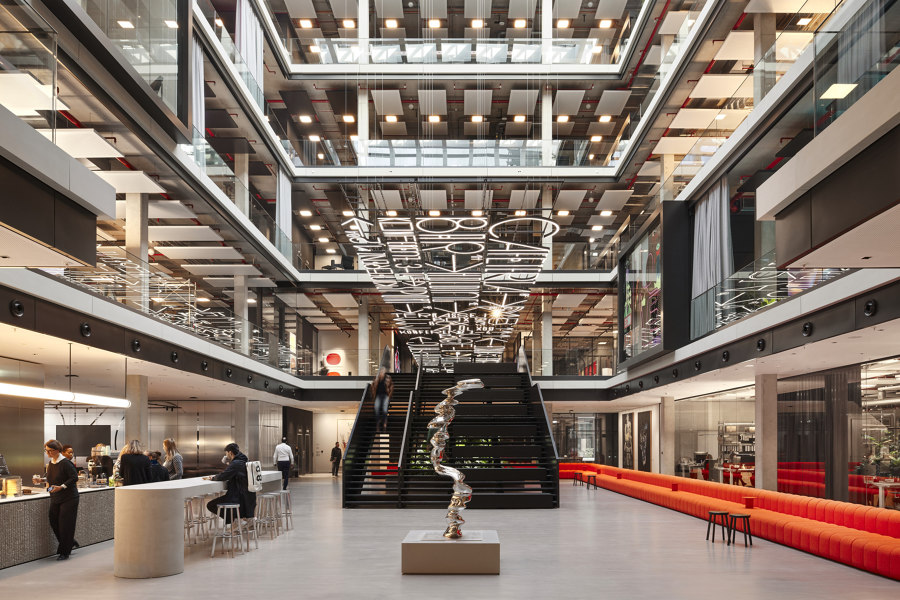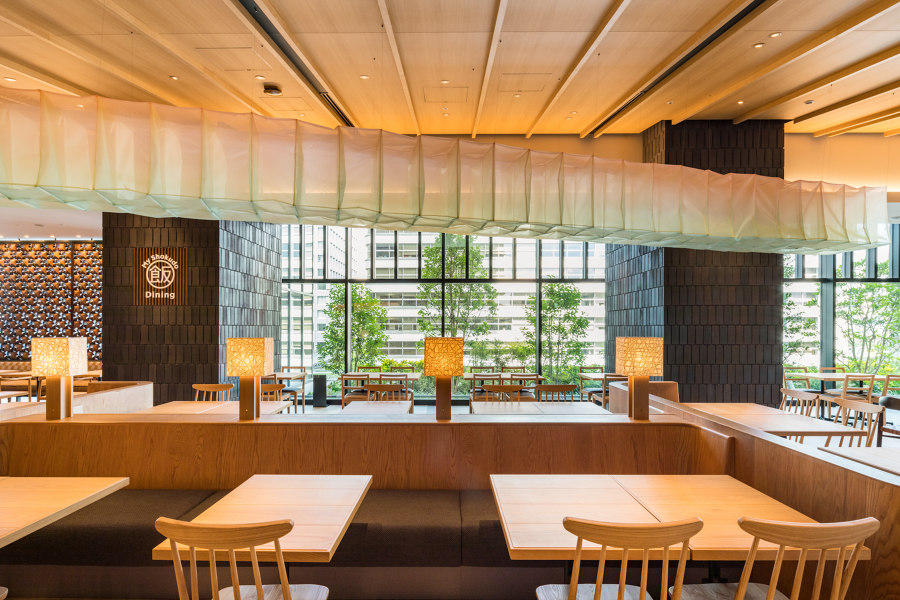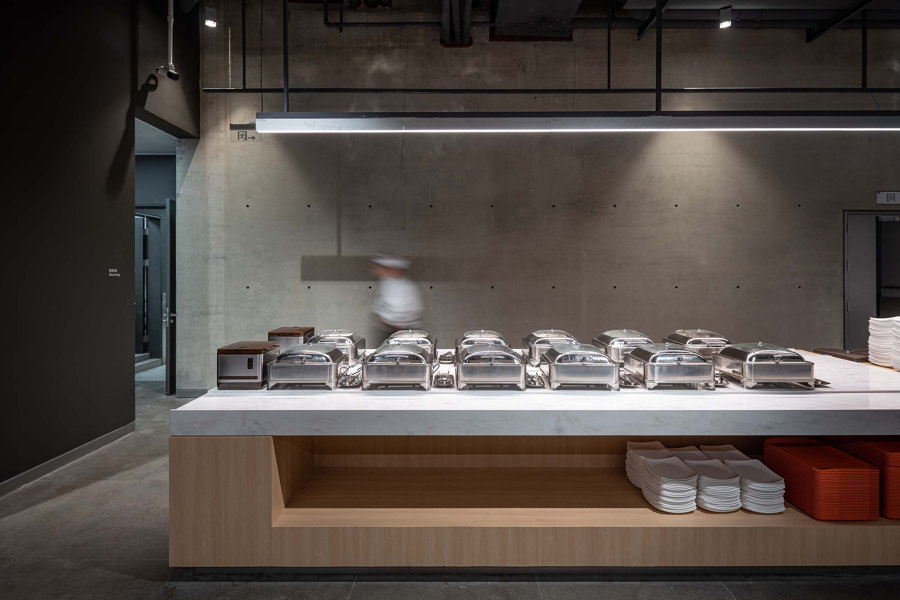The return of the office cafeteria means more social workplaces
Texte par James Wormald
25.09.23
As our workplaces shift focus from work to wellbeing, the lunch break is changing with them. Helping to improve relaxation, communication and creativity, the office canteen is on its way back.
The House of Communication’s cafeteria allows 1700 employees from 40 separate agencies in three different buildings to get to know each other better in one large shared space. Photo: Mark Seelen

The House of Communication’s cafeteria allows 1700 employees from 40 separate agencies in three different buildings to get to know each other better in one large shared space. Photo: Mark Seelen
×The atmospheric sadness of a typical office ‘kitchen’ – and by kitchen I mean an old kettle, two rusty spoons (both missing) and three flimsy chairs around a one-person table – can be the root of much employee unrest. But when the alternatives mean either walking through the city smog or hunching over a desk with a Tupperware sandwich, dropping crumbs on the keyboard, there isn’t much choice.
When long meetings cause missed mealtimes, resulting low blood sugar causes reduced brain activity, creativity and productivity
In the post-pandemic workplace, however, where employee wellness demands respect and employers themselves are searching for ways to make their offices more appealing in a hybrid schedule, the age-old canteen format might just find its way back onto the menu. Here is a selection of projects that prove it can work, and how.
Sony Music’s Berlin HQ allows employees to cut both records and cakes to celebrate, with a suitably glam cafeteria space (top) a short distance from meeting rooms (middle, bottom). Photo: Stefan Wolf Lucks

Sony Music’s Berlin HQ allows employees to cut both records and cakes to celebrate, with a suitably glam cafeteria space (top) a short distance from meeting rooms (middle, bottom). Photo: Stefan Wolf Lucks
×Continuous creativity: re-energise with catered meetings
When long-running meetings overlap with low blood sugar from missed mealtimes, the body descends into a destructive spiral of reduced brain activity and creativity, causing low productivity and missed deadlines. The stereotypical solution is a drawer of takeaway menus and a deep dive into petty cash, but the low food quality and restriction of choice can make employees feel even worse. When an office is installed with a fully functioning cafeteria on site, however, a quick 30-minute food break is both honest and refreshingly healthy.
‘The café becomes a focal point for the office, with a stage and a bar’
At Sony Music’s new HQ in Berlin, Germany, for example, a serviced cafeteria is positioned down the corridor from three large round-table meeting rooms, an edit suite and a professional recording studio on the ground floor. Once the record is cut, meanwhile, as project architects studio karhard explain, ‘the café becomes a focal point for the office, with a stage and bar.’
With an unbroken landscape to enjoy, the Rosalind Building’s cafeteria allows employees to truly relax while taking in the view, amongst calming neutral tones and materials. Photo: Fernándo Alda

With an unbroken landscape to enjoy, the Rosalind Building’s cafeteria allows employees to truly relax while taking in the view, amongst calming neutral tones and materials. Photo: Fernándo Alda
×Refresh body and mind with a landscaped lunch break
When office buildings squeeze themselves into cities, they’re spoilt with a variety of nearby eateries in which to lunch. When a company cuts costs by building or renting space outside the city, however, the options are limited. Having easy access to quality fresh food can be imperative to retaining employee wellness and morale, but there’s an additional advantage to working on the outskirts of town. Along with adding square feet to the work environment, office spaces set out in the sticks also feature excellent views of the surrounding landscape.
Having easy access to quality fresh food can be imperative to retaining employee wellness and morale
At the Rosalind Building, for example – an expansion of the Andalusia Technology Park in Málaga, Spain – a spacious and contemporary cafeteria is available on the building’s ground floor for its tenants to share. The building’s ‘long facades frame the landscape,’ explain architects Estudio Primitivo González | eGa, ‘leaving a strip of vision at the height of a sitting person, from which the profile of the distant mountains can be appreciated.’
A long table with space for up to 80 employees (top, middle) and a 30-metre-long corner sofa (bottom) both reside in the House of Communication’s shared cafeteria space. Photo: Mark Seelen
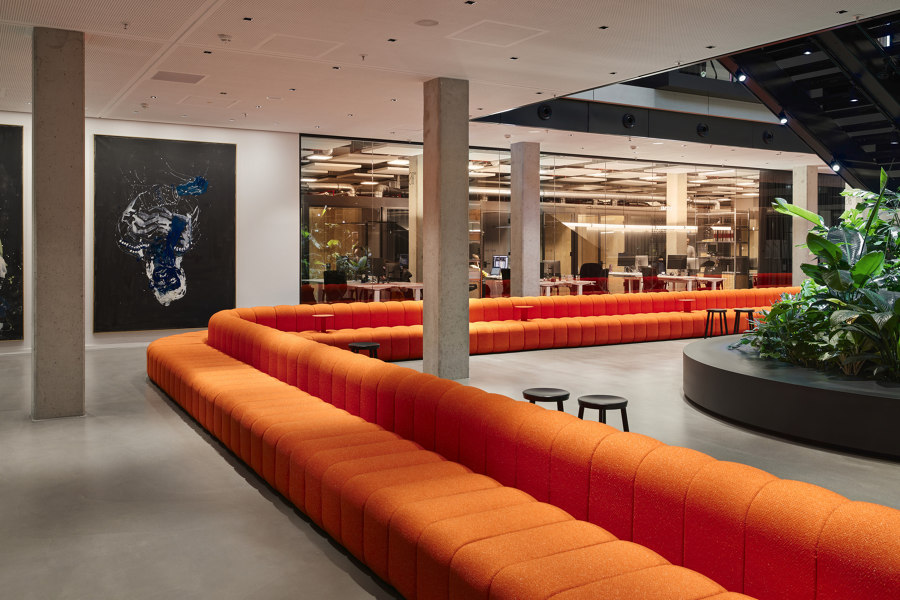
A long table with space for up to 80 employees (top, middle) and a 30-metre-long corner sofa (bottom) both reside in the House of Communication’s shared cafeteria space. Photo: Mark Seelen
×Making the office social feel more social
As much as time spent in the home office is welcome, many of us still look forward to socialising with our ‘work family’ in the more traditional office environment. And workplaces that fail to provide suitable social spaces for employees to interact both in and out of working hours are struggling with the morale, productivity and hybrid scheduling of their teams.
Many of us look forward to socialising with our ‘work family’ in the traditional office environment
House of Communication in Munich, Germany, for example, is an office space for the Serviceplan Group of communication agencies. The space connects three separate buildings with bridges, allowing 1700 employees from 40 agencies to get together with ease. As project architects HENN explain, they ‘devised the headquarters as a small city, a concept known as office urbanism. Like a city, the House of Communication includes spaces to meet, eat and relax, including a space for 80 employees to sit together at a single wooden table in the canteen.’
Restaurants and bars on the Tokiwabashi Tower’s lower levels and terraces (top) and the office-accessible MY Shokudo cafeteria (middle, bottom). Photo: Kawasumi Kobayashi Kenji Photograph Office

Restaurants and bars on the Tokiwabashi Tower’s lower levels and terraces (top) and the office-accessible MY Shokudo cafeteria (middle, bottom). Photo: Kawasumi Kobayashi Kenji Photograph Office
×Mixed-use office buildings, meanwhile, like the Tokiwabashi Tower in Tokyo, Japan, provide employees with a nearby spot for easy and impromptu post-work socials. Along with three levels of high-quality restaurants and bars on its lower floors and terraces, the Tokiwabashi Tower also houses a cafeteria, MY Shokudo, which ‘primarily serves employees in the building,’ explain architects Mitsubishi Jisho Sekkei, but which opens up to the neighbourhood in the evening, encouraging employees to socialise out of work hours, outside their work environment, but without having to leave the building.
The high-quality self-service canteen (top, middle) and materials library (bottom) at GOA (Group of Architects)’s self-designed office building in Hangzhou, China. Photo: GOA (Group of Architects)
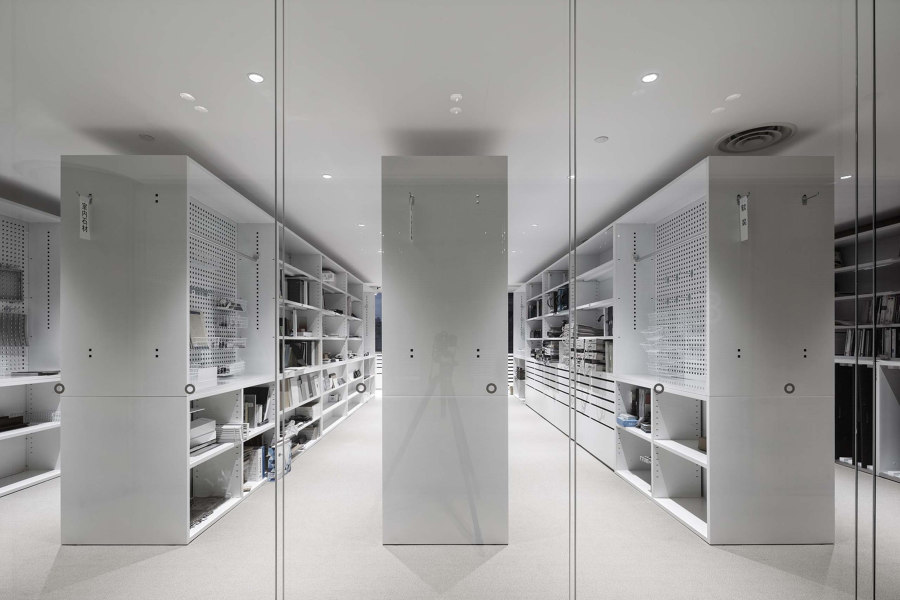
The high-quality self-service canteen (top, middle) and materials library (bottom) at GOA (Group of Architects)’s self-designed office building in Hangzhou, China. Photo: GOA (Group of Architects)
×Architects doing it for themselves
Instead of reading reports on what employees supposedly want from their own office environments, office spaces designed by the very architects who work in them – like GOA (Group of Architects)’s new headquarters in Hangzhou, China – offer insight into the features employees themselves include, when they hold the reins. And one of the architecture studio’s stand-out self-customised features is its luxury canteen.
Offices designed by the architects who work in them offer insight into the features employees want included
In a space designed specifically for collaborating and learning from each other, the building boasts conference centres and libraries – of both printed works and materials – large and small, as well as a canteen set in ‘the sunken courtyard,’ as the architects explain, providing ‘an attractive dining environment – plenty of sunlight and Karesansui landscape – bringing diners a wonderful experience through a transparent interface.’
© Architonic
Head to the Architonic Magazine for more insights on the latest products, trends and practices in architecture and design, or find inspiration in a whole world of projects from around the globe through ArchDaily’s architecture catalogue.












